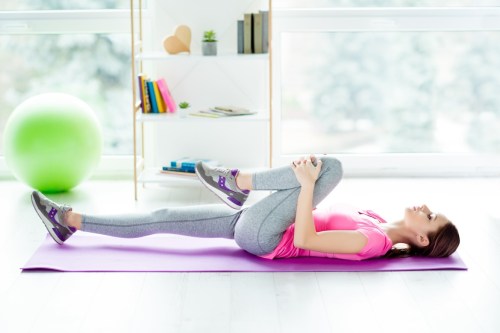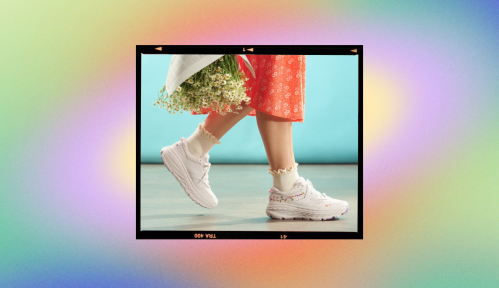When you were a kid, sitting in the cross-legged pose, aka criss-cross-applesauce, for a long period of time meant that it was either show-and-tell day, or that your teacher was reading you a particularly compelling chapter from one of the Boxcar Kids books.
Experts in This Article
physical therapist and founder of The PHYT Collective
physical therapist and founder of Exchange Physical Therapy Group
physical therapist and certified trauma-informed breathwork practitioner
As an adult, though, it likely means that you’re parked on your couch with your computer in your lap, trying to create an ergonomic workspace. If this sounds familiar (hi, it’s us!), there is some good news and not-so-good news when it comes to sitting in the cross-legged pose.
The benefits of sitting in cross-legged pose
First, the good news. There’s a reason why we’re naturally drawn to sit cross-legged. It’s not only comfortable, but it also provides your hips and butt muscles with a nice stretch.
“This will, in some cases, take some pressure off the lower back and feel more comfortable,” explains Kate Crawford, PT, a physical therapist and certified trauma-informed breathwork practitioner. Furthermore, “this sitting position has been shown to help with circulation, can strengthen your back, will open up your hips and groin, and has been shown to be a great position for grounding, which will, in turn, promote feelings of relaxation in the body.”
So yes, there are some cross-legged pose benefits.
That said, sitting cross-leggedis not for everyone. Crawford recommends avoiding this position if you have had a hip or knee replacement; acute back pain; untreated or active arthritic flare-ups in the hips, knees, and ankles; or acute sciatica. In these cases, it’s best to practice some of the other best sitting positions.
How sitting in cross-legged pose all day affects the body
Now, the not-so-good news about sitting cross-legged all day. If this position is your go-to, you’ve likely realized that sitting with your legs perched under your body is decidedly not as comfortable as it used to be, and untwisting your body at the end of the day can leave your hips screaming.
“When we stay in any one position for too long, we place increased stress on the tissues around the area,” says physical therapist Ashley Speights, DPT.
According to physical therapist Jaclyn Fulop, PT, founder of Exchange Physical Therapy Group, sitting in any one position for more than 20 minutes can cause a knot in your muscle that becomes tender to touch, so it’s important to change the way you’re sitting every 20 minutes.
“When we sit cross-legged, we tend to put a lot of stress on our sciatic nerve, which is the area that branches from your lower back through your hips and glutes and down each leg,” Speights says.
She explains that while you likely won’t wind up with any injuries from sitting in this position for too long, you may wind up with some irritation in your muscles.
“Sitting in this position for too long will cause the muscles of the lower back to tire out and add stress to the lumbar spine,” Crawford adds. “In turn, this could produce lower back pain or a feeling of ‘fatigue.’ It also adds stress to the joints of the hip and knee.”
So how long can you sit criss-cross applesauce without the negative effects? Again, the sweet spot is 20 minutes, max. Ideally, Crawford says it’s best to assume a wide variety of postures throughout your day. In other words, if you plan on sitting in cross-legged pose on the couch while working, be sure to take lots of breaks, and while you’re at it, do some easy stretches for relief.
“You will want to stretch the posterior chain if you find yourself often sitting in this position, particularly the hamstrings and calf muscles,” Fulop says. “The hip flexors and IT bands are also shortened when sitting crisscrossed so stretching these large muscle groups also becomes important.”
There’s a reason why we’re naturally drawn to sit cross-legged. It’s not only comfortable, but it also provides your hips and butt muscles with a nice stretch.
The best stretches to do after sitting in cross-legged pose
Here, the pros lay out the best ways to unwind those aching muscles—think of them as desk job stretches if your desk is really the couch (or bed or floor).
1. Half-kneeling hip flexor stretch

- 1.Start in a half-kneeling position by stepping your left forward and bending it to 90 degrees. Your back knee should be bent on the ground with your toes tucked.
- 2.Tuck your pelvis underneath you, and gently lean forward as you bend your front knee until you feel a stretch along the front of your hip.
- 3.Hold for 30 seconds.
- 4.Repeat twice on each leg.
2. Supine piriformis stretch
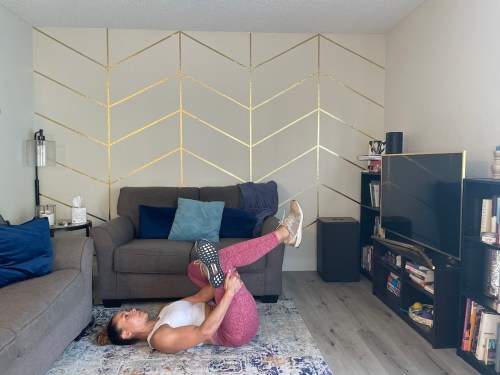
- 1.Lie on your back with your knees bent and feet planted on the floor.
- 2.Lift both feet off the ground so your legs are bent at a 90-degree angle.
- 3.Bring your left knee toward your chest, rotate it outwardly (to the left), and rest your left foot on your right knee in a figure-four position.
- 4.Pull your knee toward your opposite shoulder until you feel a stretch in your glute.
- 5.Repeat on the other side.
3. IT band stretch
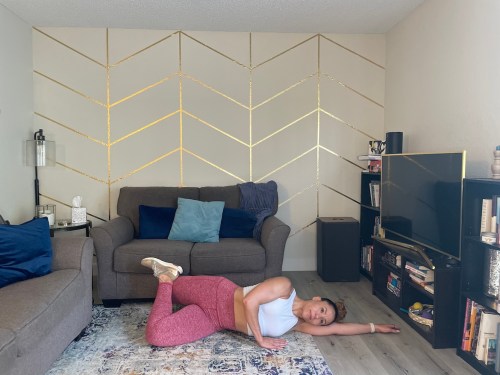
- 1.Lying on the left side of your body, bend your top knee so that your foot comes up behind you toward your glutes, and lift that knee up as high toward the ceiling as you can.
- 2.Bring that knee down toward the ground behind you, then place your other calf on top of it to push it into the floor.
- 3.Hold for 30 seconds.
- 4.Repeat on the other side.
4. Short dog

- 1.Start on your hands and knees in a tabletop position.
- 2.Inhale and engage your core muscles to tuck your toes and lift your knees up to straighten the legs.
- 3.Lengthen your tailbone up toward the sky so your body forms an inverted “V” position.
- 4.Walk your feet in slightly closer to your head so that your heels touch the ground.
- 5.Start peddling out your knees.
- 6.When that starts to feel nice and juicy, walk your feet back to a regular downward dog for a deeper stretch.
5. Waterfall
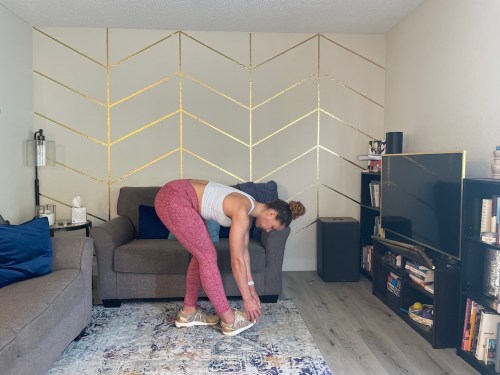
- 1.Start standing up with your left knee gently bent and your right leg extended slightly out in front of you.
- 2.Point the toes of your right foot up toward the sky and keep your heel planted.
- 3.Stretch your arms down toward your right foot, folding your body over your front heel.
- 4.Flow slowly back up to standing.
- 5.Repeat on the other side.
Myths about sitting in cross-legged pose
1. Sitting cross-legged is bad for your posture
“There is no such thing as perfect posture,” Crawford says. So it’s not that sitting cross-legged contributes to bad posture. Rather, if you experience pain from sitting in this position, she says it means that there is tightness somewhere in the body that’s not allowing you to sit that way comfortably, or maybe you just need to take a movement break.
2. Sitting cross-legged is bad for your knees
This sitting position isn’t “bad” for your knees, Crawford says. If you’ve been sitting this way for a long time (like all day), she says it’s more likely that you just need to get up and move around a bit.
3. Crossing your legs will give you varicose veins
Contrary to what you may have heard, Crawford says there is no direct connection between how you sit and the likelihood of developing varicose veins. So if that is a concern for you, there’s no need to ditch the cross-legged pose for good.
How to make sitting cross-legged work for you
Sitting in the cross-legged pose is perfectly fine for most folks, but there are a few guidelines to follow. It’s vital that you don’t round your back and hunch your shoulders forward—think “tall spine,” Crawford says.
For those who don’t find the cross-legged pose to be super comfortable, they may just need to incorporate some modifications. If your knees are elevated off the ground, try sitting on a yoga block or a thick blanket.
“This will bring your hips a little higher than your knees and should feel more comfortable,” Crawford says. “You can also try placing a blanket, pillow, or block under the outside of each knee. This will relieve added stress at the hips and knees.”
Sitting on a block or blanket can also be helpful if you feel a pinch in your lower back when sitting in cross-legged pose because it can help your pelvis establish a more neutral position, Crawford says. For a pinched-back feeling, she also suggests adjusting your posture by engaging your core muscles and positioning your shoulders directly over your hips so you’re not leaning too far forward or too far back.
Pro tip: Try this posture with your back up against a wall, which Crawford says can help let your body know what a straight spine should feel like.
And again, don’t forget to break up long periods of sitting in the cross-legged pose with some after-work stretches to give your body some much-needed TLC.
Sign Up for Our Daily Newsletter
Get all the latest in wellness, trends, food, fitness, beauty, and more delivered right to your inbox.
Got it, you've been added to our email list.
